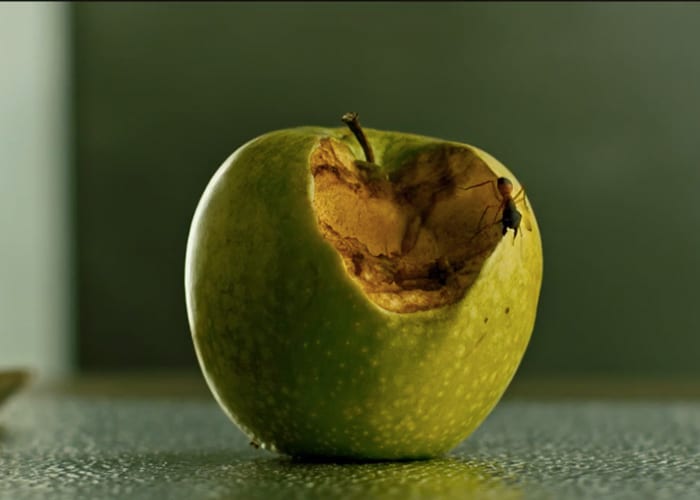Coralie Fargeat’s 2017 rape-revenge tale Revenge is anything but subtle. It bashes the audience over the head with its message about feminine rage and the fantasy of killing not only your rapists but their supporters, too. Much of Revenge’s shocking and gorgeous imagery is centered around the protagonist Jen’s body, but one of its most haunting shots involves a green apple and a single, creeping ant.
Revenge follows Jen (Matilda Lutz) as she is taken on vacation with her boyfriend Richard (Kevin Janssens), who just so happens to have a wife and kids. His friends unexpectedly crash their fun, but they adapt and the champagne flows, the music blasts, and the laughs abound. However, the fun promptly ends when one of Richard’s friends, Stan (Vincent Colombe), rapes Jen and Richard does nothing about it. When Jen threatens to expose their affair, Richard throws her off a cliff in an effort to silence her. But Jen is more than just a pretty face and she rises from the ashes to enact her revenge.
But before Jen goes on her murderous rampage, she takes a bite from an apple. It is a simple action part of her morning routine. But, that apple morphs into something much bigger than itself as it is discarded on the counter and left to be consumed by pests. The apple becomes a symbol for Jen, a perfect-seeming form that glistens and entices with its smooth exterior. It is bright, without blemishes, and just what the body craves. However, with Jen’s bite, the softer white inside is exposed for the world to see.
In this shot, that white flesh has started to oxidize and turn brown, making what seemed so perfect into something broken and easily thrown away. It sits on the counter, forgotten after a night of partying as the light of day reveals its withering carcass. This again represents Jen, who appears so perfect but becomes a piece of trash in the eyes of men once she is raped. That bite foreshadows how Jen herself is set to be partially consumed then left to rot in the baking hot sun. Jen’s bitemark comes in the form of a puncture wound caused when she is impaled upon a tree. As a branch pierces her stomach, that which was once perfect is destroyed.
Then there is, of course, the ant that creeps around the side of the apple, taking advantage of that exposed flesh for a quick, opportunistic snack. Just as Jen is about to be consumed to satiate Stan’s sexual appetite, the apple is left to be taken apart by a pest. Stan, of course, is the pest, a small man who eyes Jen with hungry eyes and an empty stomach. He crawls all over Jen, both with his gaze and his physical touch, scrambling to get as much as he can while he has her in his grasp. The ant stands stark with its black body against the smooth green skin and shriveling innards of the apple, something angular and strange against the beauty of the fruit. The ants make another appearance as Jen’s body dangles from the tree, crawling all over her body and her wound as visual metaphors meld into one; just as the ant crawled over the rotting apple, the ants crawl over the damaged Jen.
Importantly, the initial bite is performed by Jen herself, which conjures up the religious imagery of Eve taking a bite of the apple—or forbidden fruit—in the Garden of Eden. Like Eve, Jen has taken a bite of this symbolic fruit, though at first she only thinks of it as a quick breakfast. But as the narrative progresses and Jen’s desert oasis quickly becomes a stark, sweltering hell, the apple stands for something more than just transformation. As the apple perches on the counter, its flesh turning brown, it becomes a symbol of corruption as well as transformation.
Jen, like Eve, must wander into the desert to find her way to salvation. Jen’s apple is the forbidden fruit that connotes her actions were seen as “asking for it” and that she deserves to be treated as such. However, while Jen is the one to bite into the apple, she shouldn’t be blamed for the events to come, just as Eve shouldn’t have to bear the burden as the mother of sin.
On the most basic and obvious level, this shot of a partially eaten apple is a simple visual metaphor for the act of consumption. Yes, that is obvious, but that is the point. Fargeat is not going for subtlety or a quiet examination of female rage; she wants to use these provocative and unmistakable images to make the audience focus on her message. They cannot avoid the ideas she wishes to convey and there is no way for someone to interpret this as anything but a film about a woman righting the wrongs committed against her.
In this simple shot, Fargeat is able to foreshadow the traumatic events to come, as well as distill her message about the female body. To men, the female body is a piece of meat, or fruit in this case, that is waiting to be consumed and discarded. While Revenge may seem simple in story, it is packed with meaning as Fargeat uses the film as a space to investigate and interrogate the ways in which women are viewed and treated every single day. With just an apple and an ant in frame, Fargeat has told the beginning of her story, one that starts with hunger and decay.

